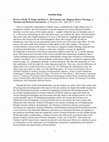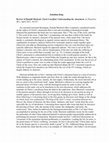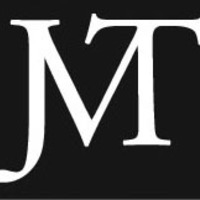Book Reviews by Jonathan King
Trinity Journal 39/2, 2018

Themelios, 2013
This is a wonderful compendium of fifteen essays, contributed by a high caliber array of evangeli... more This is a wonderful compendium of fifteen essays, contributed by a high caliber array of evangelical scholars, that all concentrate on the development of various classical Christian doctrines over the course of the modern period -roughly within the last two hundred years or so. I will not be commenting on each individual essay, as I could do the whole collection justice only with a full essay length treatment of its own. I will, however, highlight the main features and flavor that characterize the book throughout. Bruce McCormack leads off with an introductory essay that sets up expectations nicely for the rest of the essays that follow. For this reason a bit more needs to be said about it than applies to the other chapters. The project's overall intention is given at the outset: "Our idea is to organize modern theology along the lines of classical doctrinal topics or themes so that more complete coverage of significant developments in each area of doctrinal construction might be achieved" (p. 1). In this opening essay, McCormack gives his take on the critical earmarks that characterize modernity, that is, "certain defining moments in which those commitments emerge that will help us in identifying 'modern' theologies" (p. 2). Each contributor could choose whatever constructive approach they wanted to take, e.g., typological, thematic, or more historical. The only firm parameter set "was that contributors work descriptively, rather than prescriptively. That way, even the differences of opinion that exist would not become an issue" (p. 18). Following the introductory essay, the other essays given here in order cover the following topics: Trinity (Fred Sanders); Divine Attributes (Stephen R. Holmes); Scripture and Hermeneutics (Daniel J. Treier); Creation (Katherine Sonderegger); Anthropology (Kelly M. Kapic); The Person of Christ (Bruce L. McCormack); Atonement (Kevin J. Vanhoozer); Providence (John Webster); Pneumatology (Telford Work); Soteriology (Richard Lints); Christian Ethics (Brian Brock); Practical Theology (Richard R. Osmer); Ecclesiology (Veli-Matti Kärkkäinen); and Eschatology (Michael Horton).

Themelios, 2015
An esteemed seasoned theologian, Donald Macleod offers a maturely considered treatise on the subj... more An esteemed seasoned theologian, Donald Macleod offers a maturely considered treatise on the subject of Christ's atonement that is rich and rewarding in theological insight. Macleod has partitioned the book into two main parts: Part 1: The way of the cross; and Part 2: The word of the cross. Under Part 1 (comprising a bit less than a third of the book) he focuses keenly on narrative elements of the passion story, while under Part 2 his focus mainly is systematic-theological as regards various aspects of atonement theory. The combination of narrative analysis followed by systematic analysis works together quite effectively and adds an illuminating texture compared to the way such doctrinal topics are typically addressed. Macleod signals his approach upfront: "the cross is not in the first instance a doctrine, but a fact, and no interpretation of the fact can make the suffering of Christ more or less awful than it actually was" (p. 15). A distinct strength of the book, Christ's atonement is contextualized first in relation to the overall passion narrative. As Macleod notes, when it comes to Good Friday the Gospels go into slow motion, for this is the climax of Christ's mission, the culminating point of his incarnation. In this way the person of Christ is profiled in center view in order to help the reader appreciate better the work of Christ on the cross. Here one could say that Macleod adopts the NT's structural sequence in which the Gospel/Acts narratives are followed by the rest of the NT writings, which are largely didactic in character.
Books/Articles by Jonathan King
Mid-America Journal of Theology, 2020
Mark Mattes observes in his recent book, Martin Luther's Theology of Beauty: A Reappraisal, that ... more Mark Mattes observes in his recent book, Martin Luther's Theology of Beauty: A Reappraisal, that a great deal of scholarship has been given to Luther's appreciation for music, his view of worship and the liturgy, as well as his defense of icons and the visual arts. Yet how significant the theme of beauty is to Luther's theology is an area of Luther research that up until now has been almost completely overlooked. A key area of Luther's approach to beauty concerns Luther's “theology of the cross” in which Luther distinguishes God “hidden” or “absconded” from God revealed, and the “alien work” of God from that of his “proper work.” I offer a counterargument to Luther's approach to beauty. The aesthetic notion of fittingness plays a critical role in my argumentation.
A Jonathan Edwards Encyclopedia, 2017
Books by Jonathan King

Lexham Press, 2018
In The Beauty of the Lord, I begin by discussing four distinct approaches to theological aestheti... more In The Beauty of the Lord, I begin by discussing four distinct approaches to theological aesthetics, laying the groundwork for the rest of my book. Here's an extended excerpt from the Introduction —— Theological aesthetics does not imply there is homogeneity in the kind of theological scholarship on aesthetics. On the contrary, the diversity of distinct theological approaches to the subject of aesthetics can only rightly be described as heterogeneous. Effectively there are four basic categories in terms of respective concerns and the ways theology applies and is integrated: (1) natural theology of beauty, (2) theology of the arts, (3) religious aesthetics, and (4) theological aesthetics. . . . . What is not subsumed or entailed in these categories is philosophical aesthetics since its focus and substance do not necessarily address specifically theological concerns. It is not any of our interest, however, to provide a comparative evaluation of these theologies of aesthetics, nor explicate any of them except the last one that we are describing as theological aesthetics. . . . . . Theological aesthetics is premised on the canon of Scripture being the norm that norms other norms over all matters pertaining to Christian doctrine and practice. Scripture’s authority as such holds preeminence in how we interpret theologically everything considered general/natural revelation as well as expressions of culture. By extension, biblical authority presides over the domain of aesthetics in its understanding of the whole of creation—the theatrum gloriae Dei, as John Calvin (1509–1564) puts it. The basic position of theological aesthetics, argued by reasonable inference from Scripture, is that beauty corresponds in some way to the attributes of God, and as such is a communicated property or phenomenon of the opera Dei ad extra. Inferred from the previous point is that the objective reality of beauty comes from its correspondence to the attributes of God; it is this correspondence that grounds a metaphysically realist view of beauty. In general terms, theological aesthetics derives from biblical- and systematic-theological work concerning or pertaining to the aesthetic dimension as integral to and as apprehended throughout the canon of Scripture. The fruit of theological aesthetics for theology more broadly is its consequent interpretation and implications for doctrine and practice. In this work, theological aesthetics is directed primarily on the objective beauty of the person of Christ, the beauty of the work of Christ (redemption accomplished), and the beauty of Christ’s work ongoing through the Holy Spirit (redemption applied). The constructive development of this project involves a biblical-theological characterization of God’s beauty—notably in and through God the Son—as reflected economically in the phases of creation, redemption, and consummation.










Uploads
Book Reviews by Jonathan King
Books/Articles by Jonathan King
Books by Jonathan King